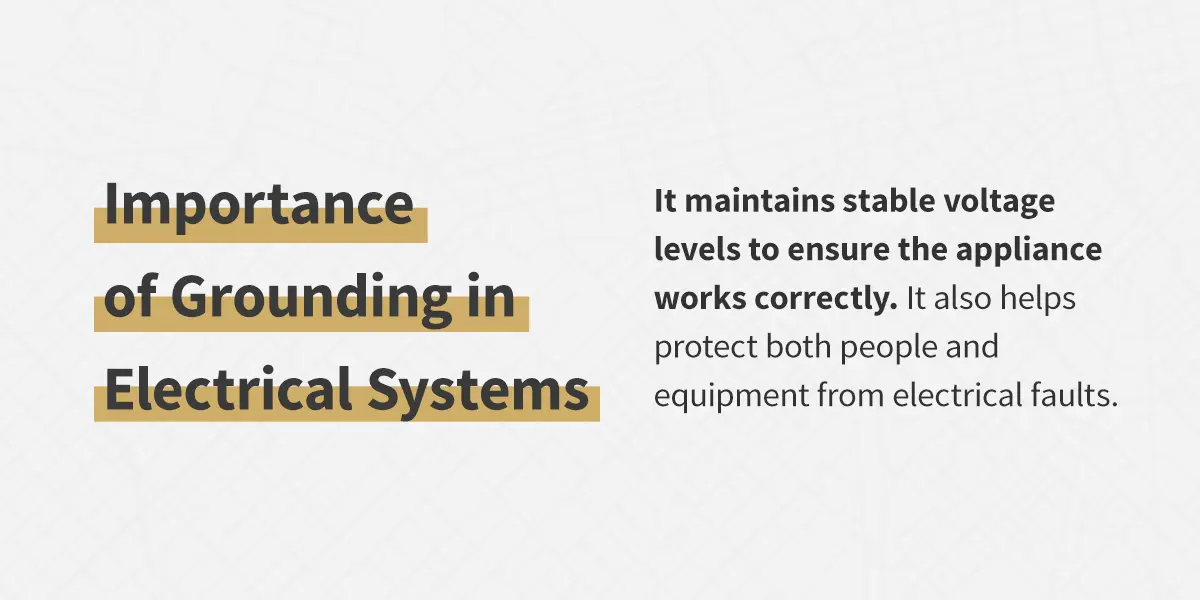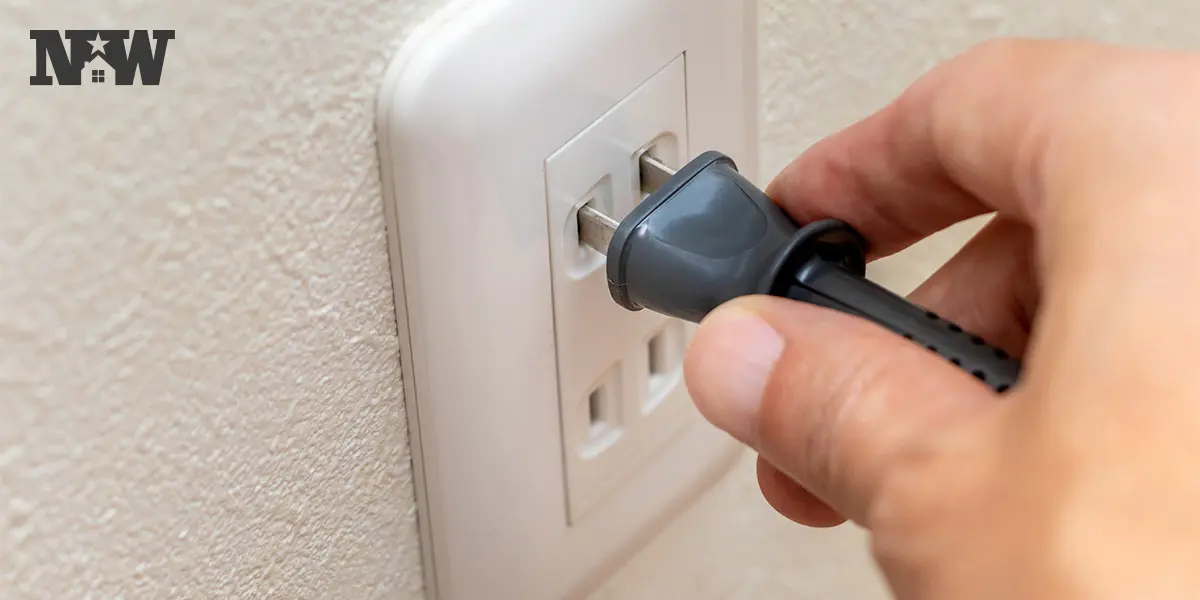At New Western, our vision is a world where every real estate transaction is simple, certain and satisfying. Therefore, we promote strict editorial integrity in each of our posts.
Ungrounded outlets do not have an attached grounding wire. Since 1962, the National Electric Code (NEC) has prohibited them in new construction to minimize the risk of electric shock and electrical equipment damage. As such, ungrounded two-prong outlets are typically only found in older homes.
Buying a house with ungrounded outlets doesn’t necessarily mean it’s against code, but certain guidelines address the replacement of these outlets in homes.
Benefits of Grounded Outlets
Grounded outlets have been required in all new home construction since the 1960s. Their purpose is to prevent electric shock. If the electricity leaves the outlet, it goes straight into the ground.
Think of electricity as water and the ground as a sink. Without a ground, the water goes all over the place. But if there is a sink (ground), the water (electricity) will go where it must. Grounded outlets help protect your electronics from power surges that can damage electronics and shorten their life span. Additional benefits of grounded outlets include:
- Shock protection: If a device malfunctions, the grounding wire carries the excess electricity away from the outlet. It prevents the electricity from passing through anyone who touches the faulty device.
- Fire prevention: Grounding helps prevent electrical fires by directing excess electricity to the ground. It lowers the risk of overheating and sparks that cause fires.
- Code compliance: Modern building codes require grounded outlets to ensure homes and workplaces meet safety standards.
- Enhanced safety: Grounded outlets prevent electrical faults by reducing the risk of electric shock. They also create a direct path for electricity to the ground, which is especially helpful in short circuits or power surges.
Risks of Ungrounded Outlets
Ungrounded outlets only have connections for a hot and neutral wire. Three-prong outlets provide a connection to a grounding wire. The grounding wire isn’t necessary for the outlet’s operation, but it’s still an important safety feature.
Electrical problems, such as ungrounded outlets, are not uncommon in older homes. It’s recommended to have a licensed electrician assess your wiring and circuits properly and make necessary repairs and replacements. Without a grounding wire, electricity doesn’t have a safe path to travel in the case of an unstable current. That means ungrounded outlets can increase the risk of:
- Electrical shock: The absence of the third grounding wire means that the outlet and the path to the breaker box remain charged, making electrocution more likely to occur.
- Fire: Without a ground, any issues with the outlet can produce sparks or arcing, which can cause walls or nearby furniture to catch fire.
- Damage to personal property: Ungrounded outlets can damage appliances or other electrical equipment by causing them to short out.
- Electronic device damage: Ungrounded outlets offer no protection for electronic devices. Without a proper ground, power surges can damage or destroy electronics.
Importance of Grounding in Electrical Systems

Grounding is essential, as it provides a path for electricity to dissipate safely into the ground. It maintains stable voltage levels to ensure the appliance works correctly. It also helps protect both people and equipment from electrical faults.
Even minor issues can become dangerous without proper grounding, causing damage and injuries. These factors make grounding fundamental in any electrical system, making homes and workplaces safer.
Methods for Grounding Outlets
Grounding is essential for safety and functionality. Several methods, each with its own steps and requirements, help ensure your outlets are properly grounded. These methods aim to prevent electrical shocks and ensure the home’s or building’s system operates correctly.
Rewiring to Add a Ground Wire
Rewiring a house can be expensive and time-consuming. There are ungrounded three-prong outlets, which means a three-prong outlet is installed with only two wires and no grounding path, but there are risks. It won’t give you the safety grounding provides, and it may not pass inspection if you choose to sell.
Ungrounded outlets can also be accompanied by electrical defects — like frayed wiring or bad connections — which can increase the risk of electrical shock or fire. Although it’s not required by law, it’s still highly advised to rewire ungrounded outlets to ensure the safety of the home and anyone on the property.
If your home has ungrounded outlets, your safest option is to rewire them all. Before rewiring, check every outlet to see if it’s ungrounded. You can use a circuit tester to check if each outlet is wired correctly and grounded.
Installing GCFI Outlets
If you’re buying a home with ungrounded outlets, a cost-effective option is to use a ground-fault circuit interrupter (GFCI) breaker or install GFCI at the individual outlets. GFCI breakers protect the entire circuit, while GFCI receptacles only protect a single outlet.
How to Add GFCI to Ungrounded Outlets
GFCI can help reduce the risk of electrocution and electrical fire by cutting power when the outlets detect an imbalance or excess electrical flow. GFCI outlets work without grounding but aren’t considered as safe as grounded outlets. Installation follows these steps:
- Cut off power to the outlet at the breaker box. You can also use a multimeter to check the outlet before moving to the next step.
- Remove the existing outlet by unscrewing it and detaching all wires. Separate the neutral wire (white) from the hot wire (black).
- The GFCI outlet comes with line and load terminals. These are usually labeled, and load terminals may also be covered with tape. Connect the hot wire to the brass terminal and the neutral wire to the silver terminal.
- Install the outlet, tighten all screws and turn the power to the outlet back on.
If the outlet has four wires, identifying the hot wire can be more challenging. After taking off the outlet and separating the wires, you’ll need to turn the power back on and use a multimeter to identify the hot wires. Once you find the wires, turn the power off and mark them with tape. The additional two wires will need to be connected to the load terminal.
While this doesn’t mean your outlets are grounded, GFCI outlets offer more protection than ungrounded outlets. It’s best to hire a licensed electrician who can assist with this installation and make sound recommendations for any additional adjustments.
Regulations and Inspections for Outlets
Ungrounded two-prong outlets can be left as-is and typically pass home inspections. However, a three-prong outlet requires a ground wire, which is a common reason why some homes don’t pass inspection.
Ungrounded GFCI outlets will also pass inspection, but the outlet will need a sticker that reads “no equipment ground.” GFCI outlets usually come with these stickers.
What Happens if a Three-Prong Outlet Is Not Grounded?
Ungrounded three-prong outlets have the same dangers as any type of ungrounded outlet. They can increase the chance of electrical shock, fire and property damage.
NEC Section 406.4(D)(1) says that any grounding path must be grounded. This means that if you plan to sell your home, you have three options:
- Install a two-prong outlet to ungrounded outlets, but this is not recommended.
- Have every three-prong outlet grounded by a professional electrician.
- Have GFCI outlets installed with a “no equipment ground” sticker.
Can You Sell a House With Two-Prong Outlets?
According to the NEC, you can sell a house with existing two-prong outlets as long as they’re working correctly. Even if you choose to replace two-prong outlets, they do not have to be rewired and upgraded. Only new construction is required to have grounded outlets.
However, two-prong outlets could still affect the sale of the home. They could be problematic for potential buyers, and some may request electrical upgrades before proceeding with the transaction.
Grounded Outlets on Home Additions and Renovations
If you are buying a house with ungrounded outlets but plan to remodel or add a room, the addition and areas with substantial renovations may be subject to code compliance. According to the International Code Council (ICC), the code enforcement process is usually initiated when a building permit application is filed.
Construction plans must be reviewed and approved, and a code inspector will make inspections as necessary to determine compliance. If something isn’t code-compliant, the code official will issue orders to correct the problem.
Consult your local code enforcement agency for ground and circuit requirements, as they may differ from area to area.
Are Grounded Outlets Dangerous?
Any outlet can be dangerous if used or wired incorrectly. However, grounded outlets offer more protection than ungrounded outlets.
To give electricity a safe path to travel, grounding wires are installed to run parallel to the hot and neutral wires. If a short circuit or fault occurs, the grounding wire will act as an emergency path to carry the electrical current away from the outlet.
Grounded outlets are an additional safety measure for you, your property and your personal belongings.
Cost Considerations for Grounding
If you’re buying a house with ungrounded outlets, having them professionally grounded can get expensive. In this situation, an electrician will have to add a ground wire to every outlet in the house.
Grounding all the outlets in your house can cost between $50 to $130 an hour, whether you are fixing or replacing outlets. Wiring costs $7 to $10 per foot and could cost between $80 to $200 per outlet. The price can go up with larger homes or down with small homes. There are roughly 75 electrical outlets in the average United States home.
How Much Does It Cost to Replace Two-Prong Outlets With Three-Prong?
If the home is grounded, you can replace your two-prong outlets with three-prong outlets. With the help of an electrician, changing to three-prong outlets can cost between $100 and $300 per outlet.
Without an electrician, three-prong outlets typically cost between $5 and $15 per outlet, and GFCI outlets cost $12 to $40.
Professional Assistance for Outlet Grounding
Hiring a professional helps ensure your home’s electrical system is safe and reliable. A licensed electrician is crucial to this process because they offer:
- Safety: Electricians are trained to handle electrical systems safely to reduce the risk of accidents.
- Proper equipment: Electricians have the right tools and knowledge to repair and test grounding systems.
- Preventive action: With ample experience, professionals can install grounding correctly to protect your appliances and electronics from power surges.
- Code compliance: Professionals will ensure the new wiring meets local electrical codes and standards.
Find the Right Investment Property for Your Needs With New Western
Home flippers should understand the process of grounding an outlet and the associated cost implications. When you are buying a home, ungrounded outlets aren’t necessarily a deal-breaker, but they can be a potential safety hazard. Plus, if you plan to sell the house down the road, some ungrounded outlets could become a problem during the home inspection.
Grounding the entire house can also be costly, but the NEC provides guidelines and alternative options for replacing ungrounded outlets.







